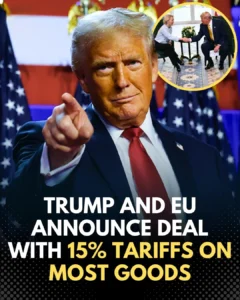
President Donald Trump and European Union leaders have reached a significant trade deal.
President Donald Trump and European Union leaders have reached a significant trade deal, imposing a 15% tariff on most European goods entering the United States.
The agreement, announced on July 27, 2025, aims to prevent a potential trade war between the U.S. and the EU.
While the 15% tariff is a reduction from the initially threatened 30%, it marks a sharp increase from the EU’s previous tariff average.
In exchange for the tariff, the EU has agreed to purchase \$750 billion worth of U.S. energy products and invest an additional \$600 billion in the U.S. economy, particularly in military equipment.
Certain sectors, such as aircraft parts, semiconductors, and some agricultural products, will benefit from zero tariffs.
However, steel imports will continue to be subject to a 50% tariff rate.
The deal is being hailed as a strategic move to strengthen U.S. economic interests and address longstanding trade imbalances.
European leaders have expressed mixed reactions, with some criticizing the deal, while others view it as a necessary compromise to avoid further economic strain.
The agreement still requires approval from EU member states before it can be fully implemented.
This move represents a shift in U.S.-EU relations and could have lasting effects on global trade dynamics.
The full impact of the deal will unfold in the coming months, with businesses and consumers on both sides of the Atlantic watching closely.





